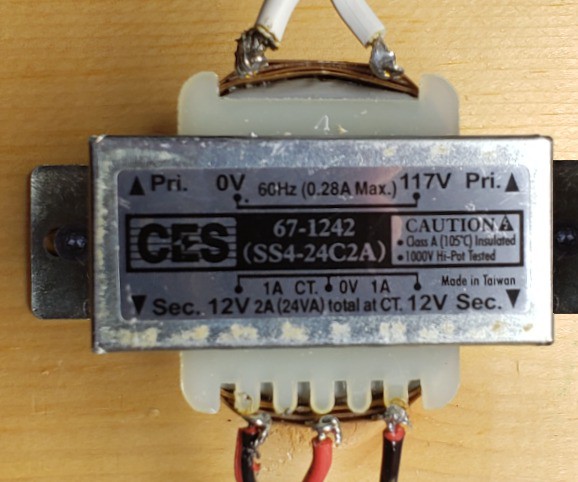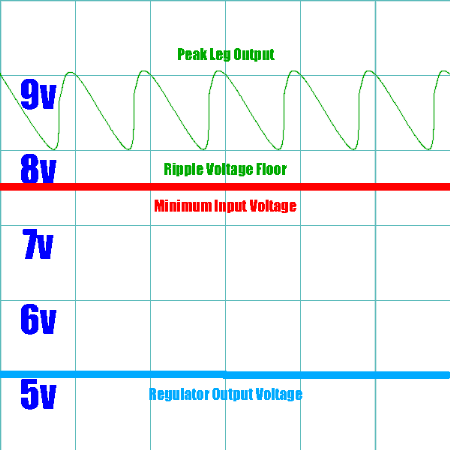§ 2.13 - Choosing a Power Transformer
Back to → Main Power Block PageThe power transformer's secondary's total and leg output voltages are always specified as an RMS voltage value.
§ 2.13.1 - Unregulated Considerations
When you choose your center-tapped transformer for an unregulated build of the Power Block, you should pick one that, when you figure its (RMS leg value times 1.414) minus the rectifier diode forward voltage drop, results in more than the minimum unregulated output voltage you want so that you don't have to use huge filter capacitors.
This is because there is always some ripple on a loaded power supply output as current is drawn from the filter capacitor(s) in between charge cycles.
The higher above your minimum acceptable output level that peak value is, the smaller the filter uF value of the capacitor(s) can be and still keep the output above your minimum desired voltage.
From there, as you increase the uF value, the ripple amplitude will decrease, and the minimum ripple voltage floor will rise.
The transformer also must provide, on each of its two legs, the amount of current you will be drawing from the power supply. For a typical 78xx- or 79xx-series voltage regulator, that maximum will likely be 1 or 1.5 amps, depending on the manufacturer of that part.
However, in order to keep the transformer running at a reasonable temperature, it is better if it can provide 1.5 to 2 times the maximum current that will be drawn from it.
§ 2.13.2 - Regulated Considerations
In order to keep the uF value of the filter capacitors reasonable, when you choose your center-tapped transformer for a regulated build of the Power Block, you should pick one that, when you multiply its RMS leg value by 1.414 minus the regulator diode voltage drop, results in at least about one volt more than the regulator IC's minimum input voltage, which you can obtain from the regulator's specification sheet:
The correct choice is not always intuitive; for instance, the peak voltage of a 12 volt secondary leg, when multiplied by 1.414 and then subtracting the .65 forward voltage drop of an Si diode, comes out as about 16.3 volts. This is about 1.8 volts more than the minimum input voltage of a typical 7812 twelve volt regulator, and so they will work in combination.
On the other hand, a 5 volt secondary leg, when multiplied by 1.414 and then subtracting the .65 forward voltage drop of a Si diode, comes out as 6.42 volts. This is below the 7.5 volt minimum input voltage of a 7805 five volt regulator, and so the regulator IC will not function correctly (or at all!) For a 7805 five volt positive regulator, most deisgns use an 8.0 volt-per-leg (center-tapped 16-volt) transformer, which, after subtracting the diode drop, provides about 10.6 volts peak, about 3.1 volts above the minimum input voltage. That's a little high, but it's the nearest value you'll likely find in a readily available transformer.
So be very careful when you choose your power transformer. Ideally, we want the ripple voltage floor of the unregulated, rectified and filtered voltage to be at least half a volt higher than the regulator's minimum input voltage. A bit higher is okay, but the regulator will run warmer; lower is not okay. Again, the filter capacitor calculator can provide the values need to ensure this is the case as long as you provide adequate transformer leg voltage to the circuitry.
Have a question? Ask us via email
, Previous Page . Next Page
o Ordering g Glossary s Sitemap u Updates


